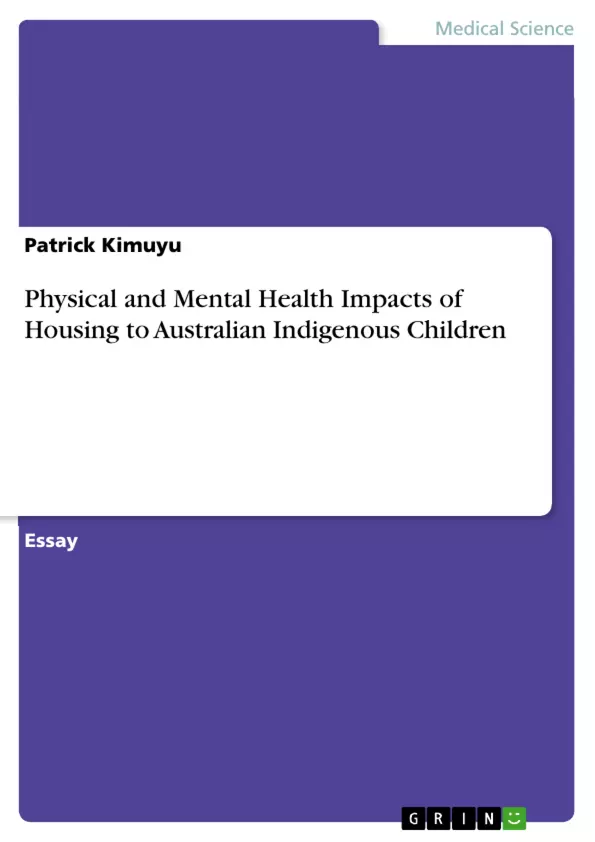In retrospect, Australian Indigenous children have poorer health than non-indigenous children and Indigenous infants have been said to be up to four times more likely to die than non-Indigenous infants. There is an increased incidence of illness in Indigenous children directly related to poor housing, compared with the rest of the Australian population. Physical and mental health implications resulting from inadequate shelter will be discussed in relation to the sub factors of building structure and overcrowding.
For the purpose of this paper, the various physical and mental health impacts of housing as shelter will be considered, with specific focus on the health of Australian Indigenous children. Housing of sufficient standard to enable health is a basic human right. Though, there are many other social factors, including socioeconomic status and remoteness, impact on housing can be considered separately as an environmental determinant of health.
Inhaltsverzeichnis (Table of Contents)
- Introduction
- Housing as a Determinant of Health for Indigenous Australians
- Impacts of Housing on Physical Health of Australian Indigenous Children
- Sanitation
- Overcrowding
- Insulation and thermal comfort
- Building Disrepair
- Impacts of Housing on Development and Mental Health for Indigenous Australian Children
- Building Structure
- Conclusion
Zielsetzung und Themenschwerpunkte (Objectives and Key Themes)
This paper explores the connection between housing and the health of Indigenous children in Australia. The author highlights the specific environmental determinants of health related to housing, including building structure, sanitation, overcrowding, and insulation, and analyzes their impact on both the physical and mental well-being of Indigenous children. The goal is to demonstrate how inadequate housing contributes to poorer health outcomes for Indigenous children compared to non-Indigenous children.
- Housing as an environmental determinant of health for Indigenous Australians
- The impact of housing conditions on the physical health of Indigenous children
- The relationship between housing and mental health development for Indigenous children
- The role of building structure and its influence on the well-being of Indigenous children
- The prevalence of illnesses and health risks associated with inadequate housing in Indigenous communities
Zusammenfassung der Kapitel (Chapter Summaries)
The introduction sets the stage by highlighting the concerning health disparities between Indigenous and non-Indigenous children in Australia, with particular emphasis on the role of inadequate housing as a contributing factor. The paper then examines the broader context of housing as a determinant of health, emphasizing the World Health Organization's definition of environmental health and the significant improvement in housing quality in Australia over the last two centuries, which has not been mirrored in Indigenous communities, especially remote ones.
The paper delves into the specific impacts of housing on the physical health of Indigenous children. It explores the significance of sanitation, highlighting the importance of clean water and sewage disposal, and analyzes the risks associated with poor sanitation, including diarrheal diseases, E. coli, giardia, and hepatitis. It also examines the issue of overcrowding and its connection to increased risk of cross-infection, as well as the health risks associated with inadequate waste disposal. The paper further investigates the implications of insufficient insulation and thermal comfort, linking it to various health problems like food poisoning, infections, and carbon monoxide poisoning. Finally, the impact of building disrepair is addressed, focusing on the detrimental effects of non-functional washing facilities, inadequate drainage, and pest infestation.
Moving beyond physical health, the paper explores the connection between housing and developmental and mental health issues among Indigenous children. It highlights the alarmingly high rate of mental health issues in this population and the demonstrable link between poor housing and child mental health. It further discusses the detrimental effects of infectious diseases, exacerbated by inadequate housing, on educational attendance and achievement, which can lead to developmental delays and additional mental health problems.
The paper concludes by reiterating the prevalence of illnesses among Indigenous children, attributing these health disparities partly to the direct effects of inadequate housing. It emphasizes the multifaceted impact of building structure, disrepair, and overcrowding on both physical and mental health, concluding that inadequate housing has significant negative health consequences for Indigenous children.
Schlüsselwörter (Keywords)
The core focus of the paper revolves around the interconnectedness of housing and health, specifically exploring the impacts of housing on Indigenous children in Australia. The key themes include housing as an environmental determinant of health, the impact of housing conditions on physical and mental well-being, the prevalence of illnesses and health risks associated with inadequate housing in Indigenous communities, and the specific role of building structure and its influence on the health of Indigenous children. Notably, the paper examines the impact of sanitation, overcrowding, insulation and thermal comfort, and building disrepair on the health of Indigenous children, highlighting the importance of these factors in addressing health disparities and improving health outcomes.
- Arbeit zitieren
- Patrick Kimuyu (Autor:in), 2018, Physical and Mental Health Impacts of Housing to Australian Indigenous Children, München, GRIN Verlag, https://www.grin.com/document/433494



